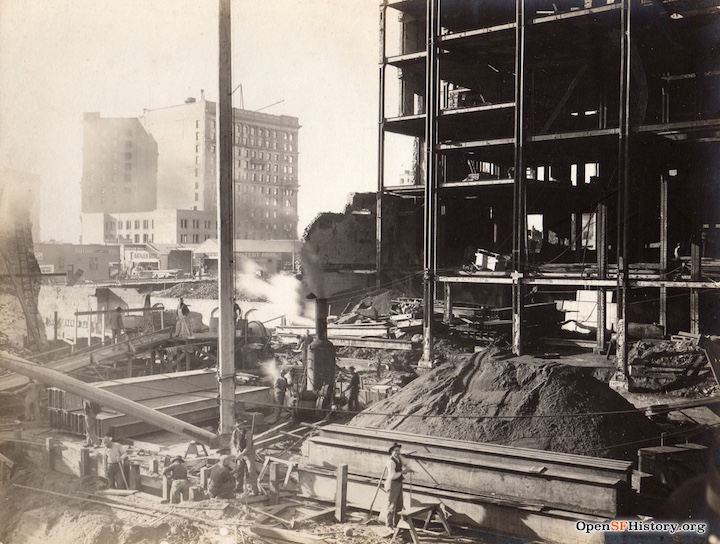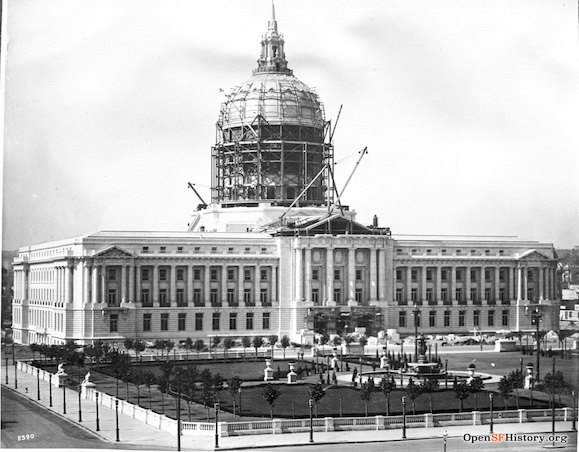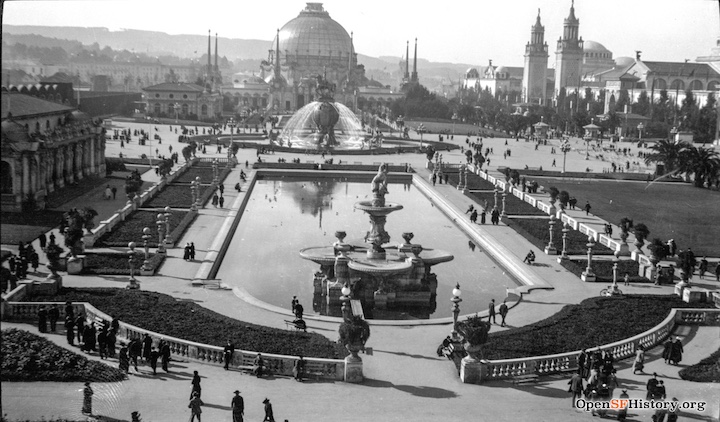Rebuilding San Francisco After the 1906 Quake
"I was there..."
by Doris Bepler Sharp, 1986, with contributions from Eva Knowles, 2024
Rebuilding on Geary near Grant in 1907.
Photo: OpenSF History / wnp 102.0030
| Doris Bepler Sharp continues to tell the story of her experience of the 1906 San Francisco Earthquake and speaks to changes in the city she noticed in its aftermath, including the shifting structural landscape, the adoption of new innovations, and the arrival to the city of paper money. As the city rebuilt itself, officials prioritized speed to protect investment and tourism, leading to a drastic transformation in the eyes of residents and nonresidents alike. |
The 1906 Earthquake and Fire vastly transformed San Francisco’s landscape, razing buildings and rendering neighborhoods unrecognizable. Reconstruction commenced almost immediately, with a strong emphasis placed on speed. City officials feared that the city would lose outside investment, which it desperately needed for its rebuilding, if it did not quickly put forth an image of strength and control. Yet while the City looked to the outside, the rapid reconstruction of San Francisco drastically changed the lives of those within it, producing a feeling of wonder for those who got to experience new sights, technologies, products, and architecture. Among these people was Doris Bepler Sharp, only ten years old at the time of the earthquake, who self-published an account of the earthquake and its aftermath when she was in her nineties. She describes the way the city around her changed, from the physical spaces she frequented to the new innovations she encountered.
Most changes to the city were obvious, such as the rebuilding of commercial and residential buildings. At first, displaced people took shelter in refugee camps and, later, in earthquake cottages, which were later dismantled as permanent structures were built. Some surviving buildings embraced a new function, such as as we see in Doris Bepler Sharp’s description of department stores relocating inside mansions on Van Ness Avenue.
Shopping at the White House and the City of Paris now had an elegance added to the lure of the merchandise, at least in the eyes of my generation. These department stores, whose previous locations had gone up in flames, reopened in the mansions left standing on the west side of Van Ness Avenue, across from the heaps of stones that we had seen blown into the air during our escape from the city. Now it seemed as though we were peering into the lives of the rich as we entered an arched doorway, crossed a marble floor, mounted a few steps to a landing under a stained glass window, and there from a board supported by sawhorses selected a pair of gloves or a handkerchief.
Though many people pushed for stricter building codes and a ban on wooden structures given the disaster that had just occurred, the desire for speed made a compromise more likely. Commercial property owners were allowed to rebuild without obtaining permits as long as their structure was only one story—iron or wood. Another reason why the city was reluctant to enforce building codes was, yet again, a fear about loss of investment; to put in place earthquake safety measures was to admit that future earthquakes were likely. According to historian Robert Hansen, building standards were relaxed by upwards of fifty percent following the earthquake, and didn’t again reach 1906 levels of strictness until the 1950s. Though obviously unsafe, this decision allowed rebuilding to take off. By 1909, 20,000 buildings had been erected.
San Francisco City Hall under construction, 1915.
Photo: OpenSF History / wnp 36.00896
Some of these were among the city’s most architecturally interesting, as they were specifically designed to impress those who viewed them. For example, San Francisco’s City Hall wasn’t completed until 1915, late in comparison to most of the other newly constructed buildings, but no one could say it wasn’t magnificent—at the time, it was the tallest building in the city, perfectly symbolic of San Francisco’s recovery. Leading Bay Area architect Julia Morgan did some of her best work following the 1906 Earthquake, including rebuilding projects at the Merchants’ Exchange and the Fairmont Hotel.
The Panama-Pacific International Exposition, 1915.
Photo: OpenSF History / wnp 14.3924
Not only had the city nearly completely rebuilt itself by 1915, but it had also constructed brand-new grounds for the Panama-Pacific International Exposition (PPIE), which it hosted that year. The exposition site was in fact built on top of rubble from the earthquake which was used as landfill. The PPIE, a world’s fair celebrating the a world’s fair celebrating the opening of the Panama Canal, was greatly anticipated for its potential to bring tourism dollars and show off the city’s recovery, thus stimulating investment. This new development was a feat in itself, as it included eleven main exhibit palaces, buildings for states and foreign countries, a racetrack, drill grounds, an aviation field, and a 70-acre amusement section. World's fairs were meant to allow nations and businesses alike to present new ideas and achievements; perfectly fitting with San Francisco’s embracing the new.
Other changes within the city were smaller but reflected this same attitude. As the world around them transformed before their eyes, San Francisco residents became more inclined to adopt new technologies. Streetcars returned to service only eight days after the earthquake, and soon, electric streetcars came to replace the much slower cable cars. Many cable car tracks were simply abandoned and built over. Household technologies were improving, too; it was also at this time that the Beplers made use of a gas stove for the first time.
Toward the end of that summer of 1906, work on the gas mains and pipes in our area was completed and our chimney repaired. Then we heard long discussions between Father and Mother about replacing our sturdy coal and wood stove that was still out on the street. “It's too rusty to bring into the kitchen again. We'd better buy a gas stove. It's easy to use. We wouldn't have dirty coal scuttles and kindling wood cluttering up the kitchen,” Father said. We suspected why Father wanted a gas stove—he had to lug up the coal each morning from the basement, and he had to chop the wood. He could spend much more time in his beloved garden if he did not have these chores.
But Mother was dubious. “How can I dry the diapers and the girls' clothing during the rainy season?” she wanted to know. These garments were usually dried on a long rack that Father had built over the stove. It was raised and lowered by a pulley. “The gas stove won't send up enough heat to dry anything.”
Father finally won out. He promised to set up the old range in the basement where Mother could use it on laundry days, which meant almost every day of the week. He said that he would also build a drying rack over it. “At other times when you want something dried in a hurry, you can just light the oven of the gas stove and put it in there.” Mother followed this advice with some disastrous results for certain diapers and panties.
Interestingly, it was also at this time that paper money was first truly implemented in San Francisco. California in fact had a tradition of being anti-paper money, as metal coinage had more stable purchasing power. Paper banknotes did not appear in California until the Civil War, at which time they had already been circulating on the East Coast for years. San Franciscans in particular were suspicious of paper money, to the point of countering the use of paper money altogether through an 1862 agreement among merchants to adhere to the gold standard. In the wake of the earthquake, the San Francisco Mint was left standing but nonfunctional due to the destruction of the city’s gas works. The facility was at this time nearly singlehandedly producing coins for the West. Banks, too, were struck by the fires and remained closed for six months.
When the city banks did open in makeshift quarters, the city people had to get used to paper money sent from the East. We had known only gold and silver coins. Aunt Nell, gathering up scraps of paper from a table one day, threw them into the fire along with some dollar bills which she did not recognize as having any value. Uncle Tom fortunately grabbed them before they were completely consumed.
Evidently, the post-earthquake world in which San Franciscans found themselves called for lifestyle changes as well as changes to the physical landscape. As San Francisco emerged from the rubble, it did so with a newfound spirit of innovation and adaptability that it would carry for decades to come.



